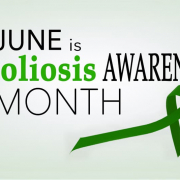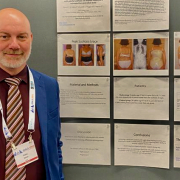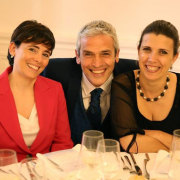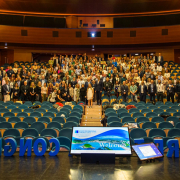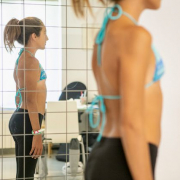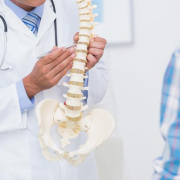June is the month of scoliosis and during this #scoliosisawarenessmonth we are sharing images, videos and testimonials on our social networks to remember the importance of it.
Today is the time for a story that years ago won our Concorsetto in 2019. A text written by a young patient, Leonardo Vener, entitled “The tin man”.
Below is an excerpt, you can read the full text on the site www.concorsetto.it
Tin Man (excerpt)
Leonardo Vener
“It was June when I started wearing a back brace. The day of the first fitting was a total disaster, although that’s the way I saw it. When I put it on and left the waiting room to try it out, I was struck by two kinds of pain. One was physical; it was clear that some adjustments were called for. The other was a different kind of pain. As I went outside, I caught sight of myself reflected in a window. For the first time, I saw myself in a brace. In the reflection, I looked different. And I mean different in a wrong way. After all, I liked the way I looked before. Staring at my image, I became aware of another change in myself: a tear raced down my cheek, chased by another, the second seeming to want to catch up with the first. After that, they came thick and fast, one after the other. A dreadful river of tears. Perhaps that was the first time I ever really cried with abandon, and I still feel somewhat ashamed of those wasted tears. Also, because I absolutely hate crying.
[…] Initially, wearing a brace wasn’t at all easy. First, I had to get used to doing everyday things in a new way. That’s not to say I was impeded, even though that’s what it felt like to begin with. The second problem was the heat because the summer two years ago was the hottest and stickiest I can ever remember. I really couldn’t stand being hot, and I was suffering even before the treatment started. Let’s say that it really doesn’t help to have a plastic brace hugging your back, not to mention that extra layer of fabric between your back and the brace, to prevent the plastic from sticking to the skin. It doesn’t help one bit!
Scoliosis is a bit like when a kid comes across a jigsaw puzzle on the floor: unexpected and catastrophic. Just as I was putting all the pieces together, and starting to see the complete picture, I suddenly found myself back at square one, only now I felt tired, which made it all the harder. I was so wrapped up in myself that I couldn’t see this new beginning as anything other than a drama and a tragedy, completely failing to realise that with puzzles, the challenge of putting them together is the fun part, not just completing them. Each piece is important, and finding exactly where it fits is like finding the key to life itself.
My brace quickly taught me that even the easy pieces of my life now needed to be reappraised and turned this way or that.
“It’s just a question of getting used to it, don’t worry”.
Up to a point, that’s true. In time, you do get used to doing up your shoes without bending over. You even find a way of picking up pencils that drop off your desk. You also get used to having to carefully plan your hours of freedom, when you can leave your brace off, to maximise that time and make the very most of it. The thing that’s hardest to get used to is the very idea of wearing one.
People can’t all be expected to see things in the same way. After all, we all look at things with our own eyes and process them with our own minds. Some manage to look to the future even in the midst of misfortune; others find that success can trigger fear. It’s like when an icy mantle envelops winter roads. Some people are nervous and fearful of slipping, whereas others just strap on their skates. Doctors belong to this second category — people who, when faced with a problem, will start to look for a possible solution.
In fact, as soon as they had my back X-rays in their hands, my doctors were already thinking about how to try and solve the problem, clinging to that one crumb of hope that, with incredible effort on my part, might turn out to be well placed. But, of course, it was up to me to seize that crumb. So, I decided to put on my skates and try out the ice. To begin with, the doctors skated alongside me, helping me along, before finally allowing me to strike out on my own. I am still skating today, even though I sometimes wobble a bit. Every so often, I look over my shoulder towards the exit, and feel tempted to give up and come off the ice. But I know that that’s not what I really want. I want to carry on wobbling until I can finally skate confidently, because once you have learned how, it’s like riding a bike — something you never forget how to do.
The first time I wore my brace in front of friends, especially my classmates, I felt very unsure. I didn’t know what to expect. I didn’t want them to see me differently somehow, because of this change in my appearance. “So, you’ve got it on then. How long have you got to wear it for? Do you have to keep it on all day? Does it hurt? …”
Well, they didn’t! Obviously, they were full of questions, and I just answered them, no problem. After that, I found that nothing had changed. Thanks to them, I realised that even with a piece of plastic around me, I am still Leo, the kid who laughs a lot, loves football, tries hard at school, thinks deeply about things. In short, I am still me! Lots of people lose touch with themselves when things happen to them. It’s easy to forget you are a good student when you get your first bad mark. When a relationship ends, you forget how happy and in love you were at the start of it. And sometimes, even knights in shining armour don’t feel so brave once they have saved their princess and are leading a normal life. But I haven’t forgotten anything about the way I was before, because simply erasing things isn’t always the way to start afresh. And I was starting afresh.
The start of my treatment was like a bump in the road of my life journey. And it took me unawares. As any driver knows, you need to slow down as you approach a bump. On the other hand, confused and angry, I pressed down on the accelerator, sacrificing some shock absorbers as a result! Looking back, I was probably going so fast that hitting the bump made me fly into the air, like a rally car off a ramp. In other words, I Iet go of reality, letting my imagination soar. But, of course, I had to come back down to earth again, which meant standing in front of a mirror and starting to do the exercises that the physiotherapist had prescribed. But that flight of fancy was what got me over that first bump, and as soon as I saw the next one ahead of me, I approached it in exactly the same way, and once again took flight. After that, with each bump it got better and better, and the crash down to earth less devastating.
Every night I go to sleep looking up at the ceiling.
I stare at it, wanting it to fall in and let me look at the stars.
I pray that tomorrow will be better than today has been, and that the sun will banish the last clouds.
I hope that the night time will cancel my fatigue, so that I can simply feel proud of myself.
I may be waiting to be grown up, so that I can put away my soft toys.
But in the meantime, I can smile and clean a bit of rust off my body.
Go for it, tin man! Tomorrow is another day”.



